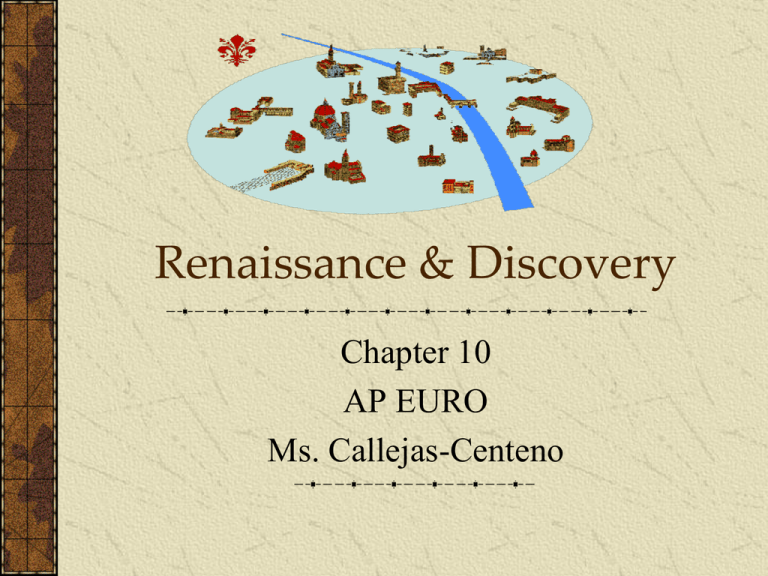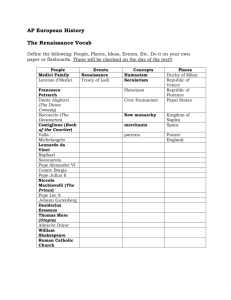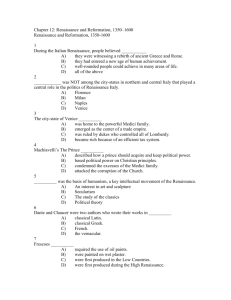Renaissance & Discovery
advertisement

Renaissance & Discovery Chapter 10 AP EURO Ms. Callejas-Centeno Free Response Essay #1 Analyze the influence of humanism on the visual arts in the Italian Renaissance. Use at least 3 specific works to support your analysis (2004) THE RENAISSANCE IN ITALY At the end of this Section I will be able to… 1. Discuss the most generally accepted definition of the term Renaissance. 2. Discuss the reasons why Florence, Italy was the birthplace of the Renaissance. 3. Demonstrate an understanding of Humanism, and explain the features of the concept. 4. Analyze the excerpt of Nicolo Machiavelli’s The Prince. 5. Exhibit an understanding of the ideal Renaissance man and woman according to Baldasare Castiglione. What is the Renaissance? An age of Recovery A transition from Medieval to Early Modern “Re-birth” of Art & Culture Began in Italy, Spread throughout Europe The Renaissance Began In… Florence, Italy 1300-1600 Italian City - States Independent Principalities: 1. Milan 2. Papal States 3. Kingdom of Naples 4. Venice 5. Florence 6. Genoa Urban Centers By the 1300’s Florence, Venice, and Milan all had populations of 100,000 people Location! Location! Location! Geography gave Italian city states: Cultural / Commercial advantage International trade 13th-14th Centuries: Trade rich cities became wealthy “city states” Why Florence, Italy? 1. Textile Industry Florentine Luxury cloth traded throughout Europe & Asia Employed 30,000 workers Why Florence, Italy? 2. Agriculture In River valleys of Tuscany & Lombardy Production of grains, wine, vegetables Agricultural surplus Why Florence, Italy? 3. Geographic Location Proximity to Mediterranean trade routes/International trade Most prosperous & Wealthy City State 5th largest city in Europe by mid 1350’s What is Humanism? A personal attitude towards life & learning Features of Humanism: 1. Obsession with Classical Antiquity 2. Individualism (celebration of the individual) Virtu- the ability to make an impact in one’s chosen field of Endeavour. 3. Secularism- people and objects in the world are important Features of Humanism 1. A Revival of Classical Antiquity Re-discovery of Greek & Roman art, culture, literature, philosophy Features of Humanism 2. Individualism- A Revived Emphasis On Individual Ability L’uomo Universale “Universal Person” Capable of achievements in many areas of his life “well rounded education” “A celebration of the individual” Features of Humanism 3. Secularismthe secular world (not associated with religion) gained importance example: artists will produce works of art that are not religious in nature. The Italian Renaissance Emphasized… Humanism An Intellectual Movement 1. based on the study of the classical works of ancient Greece & Rome 2. That advocated Studia Humanitatis (Liberal Studies) 3. & celebrated individual achievements Francesco Petrarch (1304-1374) “Father of Humanism” Scholar, poet, credited with the rediscovery of classical works. Humanists Believed In… A Well rounded liberal arts education Studia Humanitas – grammar, rhetoric, philosophy, history, poetry Secular occupations Therefore, An Ideal “Renaissance Man” Is.. 1. Well educated (studia humanitas) 2. Has “Virtu “ (overachiever) 3. Self Confident Individual 4. Inspired by the “Classics” 5. Religious, but sees beauty in the secular (non-religious) Social Classes in Florence 1. Grandi – “old rich” nobles & merchants 2. Popolo Grosso – “fat people” newly rich merchant class (bankers, capitalists) 5% of population Social Classes in Florence 3. Middle Burgher/Mediocri – shop owners, professionals, guild masters, artisans 4. Popolo minuto – “little people” lower economic classes Social Inequality in Florence 1378 Ciompi Revolt (“the wooden shoes”) Peasants “Popolo minuto “ rebelled against the upper classes Lower classes ruled Florence for 4 years until… Cosimo de’ Medici Gained control of Florence (1434) Despot – ruled with absolute power Medici family also known as the “Merchant Princes” Medici Family Background Were merchants Gained wealth Through: 1. Manufacture & commerce of textiles 2. Banking 3. Official Bankers of Catholic Church How did the de Medici Family Gain Power? Medici Family used bribery, corruption, intimidation to gain power Manipulated elections How did the de Medici Maintain Power? Amici degli amici (friends of friends) People befriended de Medici’s friends in order to gain status/ belong to “in crowd” Enemies of the de’ Medici: used intimidation tactic Brutta Figura Public humiliation against enemies Cosimo de Medici, a Patron of the Art Cosimo de’ Medici Sponsored artists to produce great works of art To beautify city For personal collection Medici Library Fillipo Brunnelleschi (architect) Cosimo’s Grandson Lorenzo “the Magnificent” (r. 14781492) continued tradition Paid artists to beautify city Medici “godfathers of the Renaissance” Maintaining Power & Social Status in Renaissance Italy Marriage an alliance of powerful, wealthy families Marriages reinforced status & power See Document 2.1: “Marriage Negotiations: The Strozzi, 1464-65” Duke & Duchess of Urbino, 1472 What does this painting tell us about marriage, wealth, and social status? Duke & Duchess of Urbino, 1472 Artist: Piero della Francesca Federico da Montefeltro & his 2nd wife, Battista Marriage: he was 35, she 13!!! Had 7 daughters She died at 26 at the birth of 7th child. ABOUT the Duke & Duchess of Urbino, 1472 http://smarthistory.khanacademy.org/pierodella-francesca-portraits-of-the-duke-andduchess-of-urbino.html Baldassare Castiglioni Wrote: The Book of the Courtier (1528 ) A social “handbook” Depicted social “do’s & do not’s” for nobles Castiglione’s Ideal “Renaissance Man” Must… 1. Possess Impeccable character, grace, & noble birth 2. Cultivate achievements –not hide accomplishments, but be modest. 3. Have a well rounded Education- arts, music , science, politics,etc. 4. Participate in the Military – Serve Prince w/ loyalty, honesty Castiglione’s Ideal “Renaissance Woman” Must… 1. Be attractive 2. Be well educated, able to paint, dance, and play a musical instrument 3. Not participate in political, artistic, or literary affairs (discussions) 4. Be an “ornament” to her upper class husband Portrait of a Lady, 1475 Christine de Pisan (1364-1430) Wrote: The Treasure of the City of Ladies (1405) a history of women designed to refute men’s myths about females male scholars debated women’s role in society Christine de Pizan “Not all men (and especially the wisest) share the opinion that it is bad for women to be educated. But it is very true that many foolish men have claimed this because it displeased them that women knew more than they did.” ― Christine de Pizan, The Book of the City of Ladies, 1405 Niccolo Machiavelli on Maintaining Power Wrote The Prince (1513) A manual on how to be an effective ruler, or a political satire? Dedicated to Lorenzo the Magnificent’s grandson Niccolo Machiavelli on Maintaining Power -The Prince Machiavelli’s advice to those in power: “If you cannot be both loved and feared, then it is better to be feared than loved. “ “Machiavellian” A term that is used to describe a ruthless ruler. CH10 RENAISSANCE ART At the end of this Section I will be able to… 1. Compare and contrast Medieval and Renaissance art. 2. Identify two works of art by : Leonardo da Vinci Raphael Michelangelo and explain the ways humanism influenced each piece. Describe the Differences… Medieval Art Renaissance Art Characteristics of Renaissance Art 1. Realistic Figures, 3-D 2. Has Depth & Perspective 3. Emotion & Expression 4. Geometrical / mathematical concepts/ Pyramid configuration 5. Artists gained recognition & fame Renaissance Art = Social & Political Status 1. Art communicated social, political & spiritual values Features of Humanism 2. Patrons of Art Used art to display wealth, power Funded artists as a way to promote own fame Renaissance Artists 1. Were inspired by Humanism 2. Tried to depict beauty, truth, nature and goodness 3. Used mathematical principles (proportions created by God) to depict perfection Giotto (1266-1337) Father of Renaissance painting From Florence Tried to imitate nature (Realistic portrayal) Adoration of the Magi, 14th cent. Masaccio (1401-1428) Brancacci Chapel painted Frescoes 1st masterpiece of Renaissance art Masaccio (1401-1428) Sandro Botticelli (1445-1510) Primavera, 1482 Obvious interest in Greek & Roman Mythology http://www.youtube.co m/watch?v=qwZn852 brII Sandro Boticelli, Primavera 1482 Donatello (1386-1466) Studied statues of antiquity David, 1428 1st life size, bronze nude in European art since antiquity Filippo Brunelleschi architect Designed il duomo Dome Cathedral of Florence built 14201436 Inspired by: Roman architecture Leon Battista Alberti Architect Designed West façade of Sant’ Andrea Inspired by classical temples Piero della Francesca 1410-1492 Duke & Duchess of Urbino Human individuality in portraiture Power, wealth, status of Duke & Duchess High Renaissance Art Flourished between 1490-1530 Shift to Rome as important cultural center 3 Artistic Giants: 1.Leonardo Da Vinci 2.Raphael 3. Michelangelo 1. Leonardo da Vinci (1452-1519) “Renaissance Man” L’uomo Universale Believed painting was “the highest form of science” 1. Artist/Sculptor 2. Scientist/Mathematician 3. Engineer/Architect 4. Inventor 5. Anatomist Leonardo da Vinci, Inventor 1. Leonardo da Vinci, Artist Mona Lisa, painted 1503-1506 About the Mona Lisa https://www.youtube.com/watch?v=3kQ_p2 EZX4Q Musee du Louvre, Paris The Last Supper Organization of space, use of perspective Karaoke Review: Leonardo Da Vinci http://www.youtube.com/watch?v=mW_gp 7SDgQM 2. Raphael (1483-1520) School of Athens (1510) Imaginary gathering of ancient philosophers Plato & Aristotle at center Painted his contemporaries as philosophical figures Balance, harmony, order, unity, symmetry 2. Raphael School of Athens Raphael’s School of Athens The School of Athens https://www.youtube.com/watch?v=uOrG6j fBzEU 3. Michelangelo “Il Divino” 1475-1564 Influenced by the depiction of: Beauty of human body, glory of human beings Beauty of figure= divine beauty La Pieta David (1504) marble, 14 ft tall Michelangelo Believed… That The human body in sculpture was the ultimate expression of mankind as a divine creation 3. Michelangelo “Il Divino” Pope Julius II summoned Michelangelo to Rome 1508 And asked him to paint ceiling of the Sistine Chapel Michelangelo reluctantly agreed Sistine Chapel (1508-1512) 9 scenes from the book of Genesis About the Sistine Chapel https://www.youtube.com/watch?v=PEE3B 8Fsuc0 Math in Renaissance Art – Golden Ratio https://www.youtube.com/watch?v=0tAZe6 pP-FM Historian Jacob Burckhardt Argued (1860) that the revival of ancient learning in 14th &15th century Italy gave rise to new secular and scientific values. Video Music Review: “Renaissance Man” http://www.youtube.com/watch?v=0CRX_ mqpzdU THE NORTHERN RENAISSANCE At the end of this Section I will be able to… 1. Describe the new methods of disseminating information in Northern Europe. 2. Discuss the characteristics of Northern Renaissance art. 3. Identify 1 work by Jan Van Eyck Pieter Brughel Albrecht Durer And describe the significance of each piece Northern Renaissance Countries north of Italy 1. Flanders in the 1400’s (“Low Countries” ) included: Modern day Northern France, Belgium, & the Netherlands 2. German states Johannes Gutenberg Invented 1st printing press with movable type 1st book printed: Gutenberg Bible (1456) -Mainz, Germany http://www.youtube.co m/watch?v=QTD0_0x ms9k Impact of Printing Press 1. Widespread literacy 2. Communication – spread of ideas , views, news 3. New jobs- Printing industry emerged 4. Books became accessible to all 5. Language – books printed in the vernacular (common languages) The Ideas of the Italian Renaissance Spread to Northern Europe… Art in the Low Countries/ Flanders Flemish artists: Influenced by Italian Renaissance Painted: 1. scenes of daily life 2. Portraits 3. Landscapes 4. Religious Themes * Used oil paints Jan Van Eyck Example of Northern Renaissance art: 1434, The Arnolfini Wedding Every Detail Is Symbolic!! Why is Giavanni not wearing shoes? Why does Giovanna look pregnant? Why does the chandelier have only 1 candle? Why is there a dog in the portrait?? Why oranges? The details MirrorStations of the cross Wedding couple & 2 others “Jan Van Eyck was here, 1434” The Details… 1 candle – a marriage candle? Or the eye of God? Dog = fidelity ; fid; fido The details… Oranges- wealth; status symbol The couple never had children. Dress symbolizes fertility http://www.youtube .com/watch?v=KJ0 O2A2WGjQ The Arnolfini Wedding- Details Albrecht Durer’s Selfies German artist 1471-1528 known for self portraits Albrecht Durer’s Selfies http://www.youtube.com/watch?v=ZoiY6Z LEKaY Pieter Bruegel, the Elder Painted scenes from everyday life (1525-1569) Peasant Wedding, 1568 http://www.youtube.com/w atch?v=G1Hs2GZKOhw Children’s Games, 1560 Bruegel Children’s Games, 1560 Bruegel Children’s Games, 1560 Bruegel Northern Humanism 1. Desiderius Erasmus Classical ideals + Civic humanism + Christian ideals of love and piety Philosophia Christi = ethical piety in imitation of Christ Northern Humanism 2. Sir Thomas Moore English Wrote: Utopia (1516) Imaginary society based on reason, tolerance. APEURO10 REVIVAL OF THE MONARCHY At the end of this Section I will be able to… 1. Identify the 3 reasons that allowed for the emergence of monarchies. 2. Discuss the legacy of Isabella of Castille and Ferdinand of Aragon (Spain). 3. Identify the 3 main elements of the colonial economy in New Spain. The Emergence of Nations Shift from divided feudal monarchies to unified national monarchies Shift to Monarchies Due to… 1. Alliance Between King & Town Townspeople (not nobles or clergy) worked in royal offices Bookkeepers, lawyers, military leaders, etc. Shift to Monarchies Due to… 2. Taxes, War, Laws Became “national”, rather than “regional” Taxes as a source of national income Shift to Monarchies Due to… 3. Monarchies began to build national armies in the 15th century Mercenary soldiers recruited from Germany & Switzerland for “king’s army” Shift to National Monarchy Case Study: Spain Isabella of Castile & Leon Married Ferdinand of Aragon 1469 Together They : 1. Secured borders 2. Expanded territories 3. Christianized Spain “Los Reyes Católicos” Spanish Unification & Expansion 1. 1481-1492 Queen Isabella & King Ferdinand’s army conquered Muslim Moors Kingdom of Granada (Southern Spain) Muslims exiled or forced to convert (“moriscos”) “Mediterranean Diaspora”: Jews exiled as well Converted Jews - “conversos” Spanish Unification & Expansion 2. 1492 Isabella & Ferdinand funded Columbus’ voyage 1521 Aztec empire fell to Spain (Hernán Cortes) 1532 Inca empire fell to Spain (Francisco Pizarro) Nueva España Ferdinand & Isabella’s Daughters Marriage = Political Alliance!! 1. Juana (1479-1555) married to Phillip the Handsome (of Austria) Outspoken, jealous, “madly in love” (at first sight) with Felipe Felipe el Hermoso (Phillip the Handsome) Juana’s Tumultuous Life Phillip grew tired of Juana… Queen Isabella died 1504 and Her father wanted Juana’s inheritance ! Betrayed by Phillip the handsome and & her father King Ferdinand!! Phillip died mysteriously @ 28 “Juana La Loca” Was Betrayed by: Her Father!! King Ferdinand! Juana declared insane, “unfit” to rule Locked in tower castle of Tordesillas 15071555 She never saw her 6 children again Juana’s Tumultuous Life Joanna “the Mad” & Phillip the Handsome had 6 children The most famous, Charles V (Carlos V) Holy Roman Empire Emperor Charles V (1500-1558) Son of Juana la Loca & Phillip the Handsome Inherited Kingdoms of: Spain, Nueva España, Austria, Naples and all Habsburg lands (Germany & Italy) ! Ferdinand & Isabella’s Daughters 2. Catherine of Aragon (1485-1536) was married @ 16 to Arthur of England (Henry VII’s Son) He died 6 months after wedding (1501) Why Spoil the Alliance? Catherine of Aragon was then married off to Arthur’s brother… King Henry VIII ! She was wife #1 (out of six) Daughter -Mary I (“bloody Mary”) Ferdinand & Isabella’s Daughters 3. Princess Isabella (jr.) Married off to Prince Alfonso of Portugal 1490 He died 1491 -Thrown off a horse Princess Isabella was so saddened by his death, she… Begged her parents to send her to A convent! Why Spoil the Alliance? 6 years later (1496) Parents married her off to Alfonso’s brother, Manuel I of Portugal She died giving birth in 1500 The World as they knew it changed… VOYAGES OF DISCOVERY Isabella, Queen of Spain Financed Christopher Columbus’s voyage in 1492 Acquired territory in the new world & created an empire as a result Video-“America Before Columbus” https://www.youtube.com/watch?v=IvBdoO G4IHs Europe in 1491 begin 7:50 1492 Columbus “sailed the ocean blue” Columbus’ voyage led to further Spanish exploration of the Americas 1. Sailed for Spain 2. was confused! 3. Thought he was in India 4. Called people “Indians” https://www.youtube.com/watch?v =IvBdoOG4IHs Video: America Before Columbus Start 13:15 14:35 exchange Did Columbus Really “Discover” America? http://www.history.com/topics/exploration/c hristopher-columbus The World After Christopher Columbus Sailed the Ocean Blue in 1492 Treaty of Tordesillas, 1494 Agreement between Spain & Portugal To divide territories in new world West of line: Spain East of Line : Portugal Hernán Cortes Defeated the Mexica Empire (Aztec) in 1521 And claimed the land for Spain Francisco Pizarro Defeated the Inca Empire in 1533 And claimed the territory for Spain Spanish Empire by 1600 Life in New Spain Bartholome de las Casas – Dominican Priest “Conquest not necessary for conversion” “Black Legend” – Spanish treatment of Native Americans inhumane Life in New Spain - Colonial Economy 1. Mining 2. Agriculture 3. Shipping Exploitation of indigenous labor African slaves also introduced Life in New Spain-Social Pyramid -“Castas” 1. Peninsulares – Born in Spain 2. Criollos – European parents, born in new world 3. Mestizos – ½ Spanish, ½ Native American 4. Mulatos – ½ African, ½ Spanish 5. Africans 6. Native Americans The Legacy of Ferdinand & Isabella New Spain Unified Spain and created a Spanish empire Territories in Mexico, Central America, South America AND the American Southwest Remained “Spanish” until the Independence movements 1810-1821




